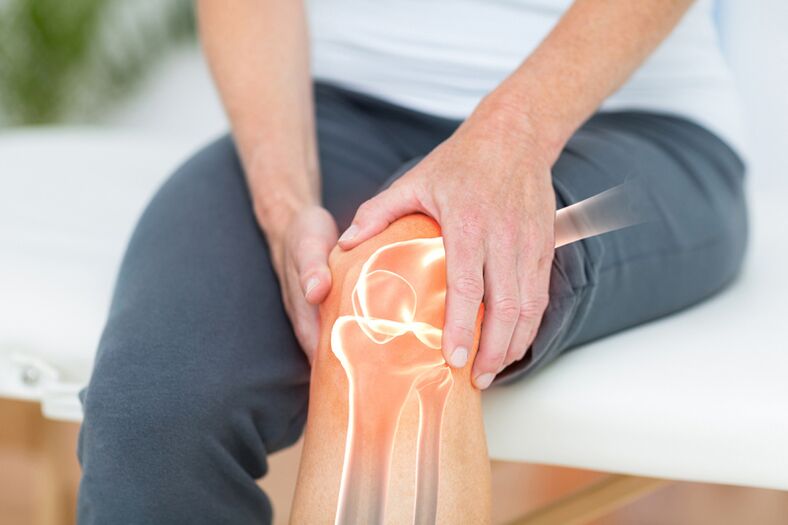
Gonarthrosis, or dry joint disease of the knee joint, is a very common disease. Such a diagnosis is usually made for people of an older age, but the joint disease "starts" much earlier, even at the age of 35-40 years. Gonarthrosis with severe symptoms significantly disrupts the entire life, so it is important to consult a doctor at the first manifestations of knee pain and receive prompt treatment.
Causes of joint disease
It can be said that knee effusion is a disease, on the one hand, due to lifestyle, on the other hand, due to age.
The immediate (internal) causes of joint disease are:
- past injuries in the joint area (sports, domestic and others),
- inflammatory diseases of the musculoskeletal system (arthritis),
- metabolic disease (diabetes),
- common orthopedic deformities of the lower extremities, including flat feet and valve feet, X-shaped deformities of the legs; These defects violate the correct movements of the knee joint, leading to deformation and degeneration of joint tissues.
Factors (external, personal) that cause joint disease:
- overweight, obese,
- female,
- age,
- continuous heavy load (work in a standing position, monotonous movements of the joints with the mass during the working day).
Under the influence of external and internal factors, the knee joint begins to degenerate and age, all its structures are involved in the process: bone, cartilage, synovial membrane, joint capsule, ligaments.
Symptoms of Arthritis
Manifestations from the knee joint are directly related to the stage of osteoarthritis. The more pathological changes in the joint and nearby tissues, the more pronounced the symptoms.
- In the early stages, a person may be disturbed by discomfort, mild pain after physical activity, which resolves on its own.
- As time passes (from 1 year to several years), the pain gradually increases, becomes permanent, joint movement is limited, appearing characteristic "creaking", "creaking" with movement.
- In the late stages of gonarthrosis, movement is severely restricted, joints are visually deformed, walking is difficult, and severe complications can develop to complete immobility ("rat joints", joint fusion, etc. ).
Diagnosis of arthropathy of the knee joint
Knee joints are detected using currently available diagnostic methods:
- Ultrasound of the knee joint allows you to assess the condition of the cartilage and bony surface of the joint, the surrounding soft tissues; is of particular importance in the early stages of rheumatic diseases, as it helps to identify pathological changes even before the onset of serious symptoms;
- X-ray is also one of the main diagnostic methods, but it is not always available, in addition, it is associated with radioactive contamination of the body;
- To clarify the diagnosis or define the features of the disease process, MRI, CT and arthroscopy are also used.
Treatment of gonarthrosis
In rheumatic diseases of the knee joint, different methods of exposure are used:
- drug treatment, including intra-articular drug use,
- towing therapy (unloading),
- physical therapy, classical and innovative methods,
- physiotherapy and massage,
- manual therapy,
- autoplasma therapy (PRP therapy).
A combination of these methods, chosen by your doctor, can relieve symptoms of joint disease, end inflammation and joint degeneration, and maintain joint mobility and range of motion.
Early stages of joint disease
In the early stages of the disease, drugs with an analgesic and restorative effect (NSAIDs, chondroprotectors, vitamins) are used according to a doctor's prescription. In addition, a variety of orthopedic devices are used: insoles, insoles, special shoes). Physical therapy exercises, manual massage, physiotherapy bring good results.
The noticeable effect of the treatment does not occur immediately, but if the doctor's recommendations are followed, the condition will improve.
Progressive joint disease
More serious measures are required here, in which cases the physician may use minimally invasive interventions - arthroscopy, introduction of enriched plasma into the joint (PRP therapy). ).
In severe forms of the joint, severe pain, accompanied by bursitis (excess fluid accumulation in the joint), corticosteroids are injected into the joint, providing rapid pain relief. This method is considered to be one of the most effective and if the intervention is done properly it is uncomplicated (rarely there may be increased pain due to a reaction to medication, adverse effects on cartilage and some other methods). other law).
Among the surgical methods that preserve joint function and range of motion, arthroplasty, arthroscopy, and arthroscopy deserve attention.
Treatment of knee osteoarthritis at a professional clinic
At a professional, modern clinic, experienced surgeons and rheumatologists will schedule an appointment. The clinic uses an individualized approach to each patient, makes an accurate diagnosis using professional equipment (ultrasound), selects the optimal combination treatment, considers joint stage and symptomsand prescribe medication in a timely manner to reduce painful manifestations.
Osteoarthritis of the knee is properly considered an age-related disease, but its development can be prevented or slowed down if the condition of the joint is assessed in time and treated (aimed at). prevention or treatment purposes).
The professional clinic offers physiotherapeutic procedures (electrophoresis, darsonval, massage, acupuncture) and minimally invasive interventions (arthroscopy, intra-articular injection) to improve the condition of the joints, theA supportive course of medication is prescribed to help reinforce and prolong the effects of the main therapy, preventing exacerbations.
























